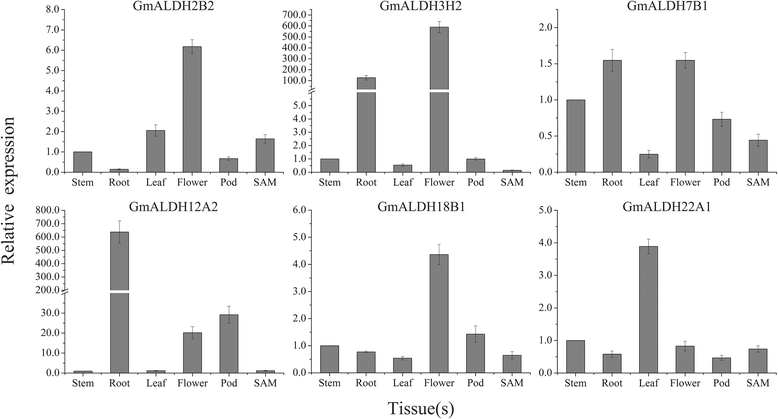Genome-wide characterization of the aldehyde dehydrogenase gene superfamily in soybean and its potential role in drought stress response
- PMID: 28687067
- PMCID: PMC5501352
- DOI: 10.1186/s12864-017-3908-y
Genome-wide characterization of the aldehyde dehydrogenase gene superfamily in soybean and its potential role in drought stress response
Abstract
Background: Aldehyde dehydrogenases (ALDHs) represent a group of enzymes that detoxify aldehydes by facilitating their oxidation to carboxylic acids, and have been shown to play roles in plant response to abiotic stresses. However, the comprehensive analysis of ALDH superfamily in soybean (Glycine max) has been limited.
Results: In present study, a total of 53 GmALDHs were identified in soybean, and grouped into 10 ALDH families according to the ALDH Gene Nomenclature Committee and phylogenetic analysis. These groupings were supported by their gene structures and conserved motifs. Soybean ALDH superfamily expanded mainly by whole genome duplication/segmental duplications. Gene network analysis identified 1146 putative co-functional genes of 51 GmALDHs. Gene Ontology (GO) enrichment analysis suggested the co-functional genes of these 51 GmALDHs were enriched (FDR < 1e-3) in the process of lipid metabolism, photosynthesis, proline catabolism, and small molecule catabolism. In addition, 22 co-functional genes of GmALDHs are related to plant response to water deprivation/water transport. GmALDHs exhibited various expression patterns in different soybean tissues. The expression levels of 13 GmALDHs were significantly up-regulated and 14 down-regulated in response to water deficit. The occurrence frequencies of three drought-responsive cis-elements (ABRE, CRT/DRE, and GTGCnTGC/G) were compared in GmALDH genes that were up-, down-, or non-regulated by water deficit. Higher frequency of these three cis-elements was observed for the group of up-regulated GmALDH genes as compared to the group of down- or non- regulated GmALDHs by drought stress, implying their potential roles in the regulation of soybean response to drought stress.
Conclusions: A total of 53 ALDH genes were identified in soybean genome and their phylogenetic relationships and duplication patterns were analyzed. The potential functions of GmALDHs were predicted by analyses of their co-functional gene networks, gene expression profiles, and cis-regulatory elements. Three GmALDH genes, including GmALDH3H2, GmALDH12A2 and GmALDH18B3, were highly induced by drought stress in soybean leaves. Our study provides a foundation for future investigations of GmALDH gene function in soybean.
Keywords: ALDH; Drought stress; Gene network; Phylogenetic analysis; Soybean; cis-element.
Conflict of interest statement
Ethics approval and consent to participate
Not applicable.
Consent for publication
Not applicable.
Competing interests
The authors declare that they have no competing interests.
Publisher’s Note
Springer Nature remains neutral with regard to jurisdictional claims in published maps and institutional affiliations.
Figures








Similar articles
-
Genome-wide analysis of the Hsf family in soybean and functional identification of GmHsf-34 involvement in drought and heat stresses.BMC Genomics. 2014 Nov 21;15(1):1009. doi: 10.1186/1471-2164-15-1009. BMC Genomics. 2014. PMID: 25416131 Free PMC article.
-
Genome-wide analysis and expression profiling of glyoxalase gene families in soybean (Glycine max) indicate their development and abiotic stress specific response.BMC Plant Biol. 2016 Apr 16;16:87. doi: 10.1186/s12870-016-0773-9. BMC Plant Biol. 2016. PMID: 27083416 Free PMC article.
-
Genome-wide analysis and expression profiling of the PIN auxin transporter gene family in soybean (Glycine max).BMC Genomics. 2015 Nov 16;16:951. doi: 10.1186/s12864-015-2149-1. BMC Genomics. 2015. PMID: 26572792 Free PMC article.
-
Genome-wide identification, evolution, and expression analysis of carbonic anhydrases genes in soybean (Glycine max).Funct Integr Genomics. 2023 Jan 14;23(1):37. doi: 10.1007/s10142-023-00966-9. Funct Integr Genomics. 2023. PMID: 36639600 Review.
-
Genetic diversity and genomic strategies for improving drought and waterlogging tolerance in soybeans.J Exp Bot. 2017 Apr 1;68(8):1835-1849. doi: 10.1093/jxb/erw433. J Exp Bot. 2017. PMID: 27927997 Review.
Cited by
-
Identification of Quantitative Trait Locus and Candidate Genes for Drought Tolerance in a Soybean Recombinant Inbred Line Population.Int J Mol Sci. 2022 Sep 16;23(18):10828. doi: 10.3390/ijms231810828. Int J Mol Sci. 2022. PMID: 36142739 Free PMC article.
-
Differential Expression of Stress Adaptation Genes in a Diatom Ulnaria acus under Different Culture Conditions.Int J Mol Sci. 2024 Feb 15;25(4):2314. doi: 10.3390/ijms25042314. Int J Mol Sci. 2024. PMID: 38396992 Free PMC article.
-
Morpho-Physiological, Biochemical, and Genetic Responses to Salinity in Medicago truncatula.Plants (Basel). 2021 Apr 20;10(4):808. doi: 10.3390/plants10040808. Plants (Basel). 2021. PMID: 33924007 Free PMC article.
-
The Ubiquitin-Conjugating Enzyme Gene Family in Longan (Dimocarpus longan Lour.): Genome-Wide Identification and Gene Expression during Flower Induction and Abiotic Stress Responses.Molecules. 2018 Mar 15;23(3):662. doi: 10.3390/molecules23030662. Molecules. 2018. PMID: 29543725 Free PMC article.
-
The Aldehyde Dehydrogenase Superfamily in Brassica napus L.: Genome-Wide Identification and Expression Analysis Under Low-Temperature Conditions.Int J Mol Sci. 2025 Mar 6;26(5):2373. doi: 10.3390/ijms26052373. Int J Mol Sci. 2025. PMID: 40076992 Free PMC article.
References
Publication types
MeSH terms
Substances
LinkOut - more resources
Full Text Sources
Other Literature Sources
Research Materials

